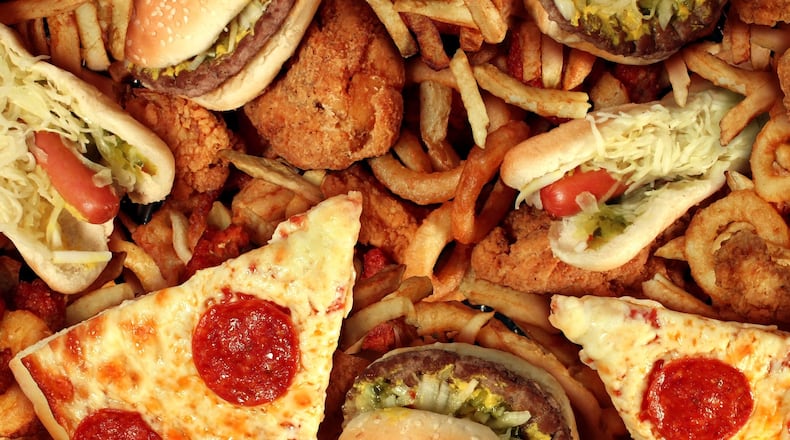“Make a plan before any party. Think about the event, the time of the event and think about the foods that will be available. Eat a light meal before so you have control over what you’re eating — eat a salad, a piece of fruit, a yogurt so you’re not hungry,” said Jennifer Dalton, MS, RD, LD, Director of Didactic Program in Dietetics, Department of Health and Sport Science at the University of Dayton. “If fruits and veggies are there, take enough to fill half of your plate and then sample things you like.”
Some simple strategies to avoid overindulgence:
Focus on the game and your plate
“Be mindful of portions. So often we get engulfed in the game that before we know it we’ve polished off a bag of chips. Check out the serving size. A serving of chips is one ounce. This could equate to 10 chips and 120 calories, which doesn’t even include chip dip,” said Kimberly Oswalt, RD, LD, Wellness Center/Cardiovascular & Pulmonary Rehab Dietitian at Miami Valley Hospital. “Being mindful simply means paying attention to our eating. When our brain is distracted, we are more likely to overeat.”
Opt for healthier versions of your game-day favorites
“Choose a healthier chip. Look for baked, whole grain tortilla chips. Then pair this with a salsa or low-fat bean dip. There are many low calorie, low fat dips available or lighten up dips by using reduced fat cheeses or substitute low-fat or fat free Greek yogurt in place of the sour cream. This not only saves calories but also adds more protein and calcium,” Oswalt said. “Make chicken wings healthier by choosing chicken breast tenders or boneless skinless chicken wings, breading with whole wheat breadcrumbs or whole wheat flour and baking instead of frying.”
Oswalt suggests buying the leanest beef you can afford or using ground turkey breast for burgers, meatballs or chili.
“Read those labels. Some ground turkey contains dark meat which isn’t lean. This could cost you 12 grams of fat and over 100 extra calories,” Oswalt said.
Pizza can get leaner, too.
“Ask for half the usual amount of cheese, then ‘run it through the garden’ — add a bunch of veggies. You’ll never miss the meat,” Oswalt said.
Be wary of liquid diet busters
“With alcoholic beverages, have a plan in mind, like, ‘I’m going to have one beer,’ and have a backup plan like diet soda or water after that,” Dalton said. “I encourage my clients to try seltzer waters; they have the carbonation and some sweet.”
“Excess alcohol can also cause us to make poor food choices. Keep alcohol intake ‘moderate’ which is defined as no more than one drink/day for women and no more than two drinks/day for men. One drink is 12 ounces of beer,” Oswalt said.
Out of sight out of mind can be an effective eating plan
“Anytime you can divert your attention from food, that’s a good strategy; moving away from the table, engage in conversation, sit while you eat instead of standing,” Dalton said. “Identify who is the pace car of eating. If you’re a fast eater, practice slowing down at home. Put down your fork between bites and alternate between foods that can be eaten quickly and those that take longer to eat. Pay attention to how full you feel and wait 20 minutes before going back for seconds.”
Hosts should offer variety, limit portions
“Balance table offerings with foods that are high in fat and sodium with nutrient-dense foods like fruits and veggies so people are introduced to foods they wouldn’t normally try. Don’t brag about low fat/healthy options — just put them out and then when people compliment it, you can talk about it,” Dalton said. “Don’t put out the full spread at once. When people see a large bowl with a large spoon, people take more. Use a plate instead of serving platter and smaller utensils and people will automatically moderate their portions and not take as much to save some for other people.”
“Serve fun-sized foods rather than large portions. For example, serve burgers on mini, whole-wheat slider buns,” Oswalt said. “Make fruits fun by making fruit skewers or serving fruit in fun single serving containers.”
About the Author
